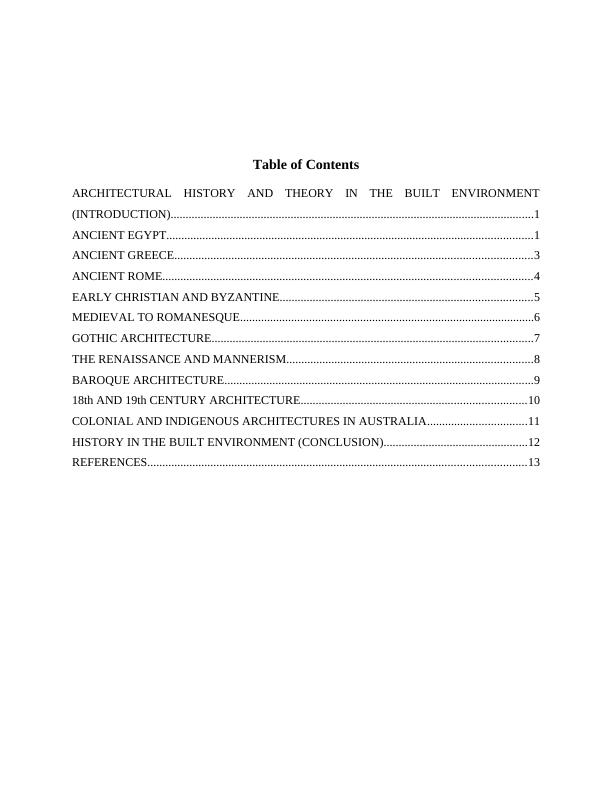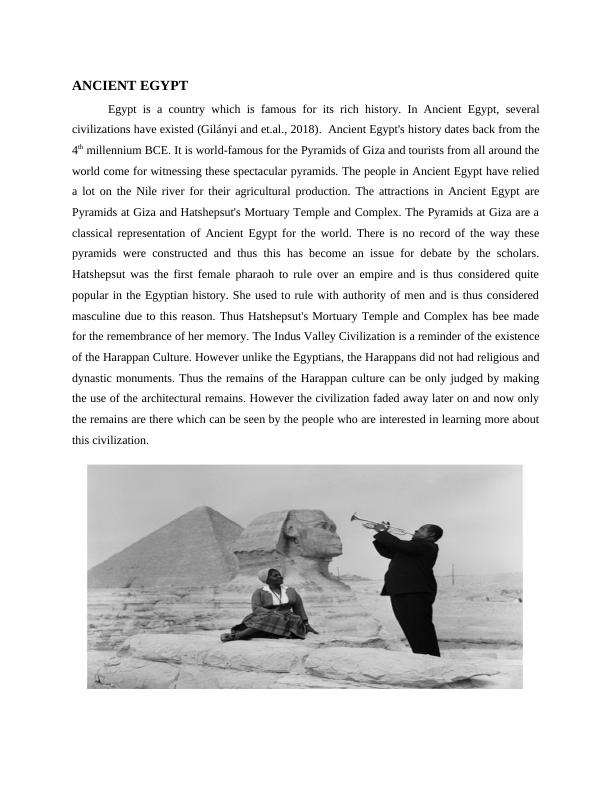Architectural History and Theory in the Built Environment
17 Pages3074 Words95 Views
Added on 2023-01-05
About This Document
This article explores the discipline of architectural history and theory, covering the forms, purpose, and evolution of architecture. It discusses ancient civilizations such as Egypt and Greece, as well as periods like the Renaissance and Baroque. Find study material and assignments on Desklib.
Architectural History and Theory in the Built Environment
Added on 2023-01-05
ShareRelated Documents
Assessment 3 – Portfolio

Table of Contents
ARCHITECTURAL HISTORY AND THEORY IN THE BUILT ENVIRONMENT
(INTRODUCTION).........................................................................................................................1
ANCIENT EGYPT..........................................................................................................................1
ANCIENT GREECE.......................................................................................................................3
ANCIENT ROME...........................................................................................................................4
EARLY CHRISTIAN AND BYZANTINE....................................................................................5
MEDIEVAL TO ROMANESQUE..................................................................................................6
GOTHIC ARCHITECTURE...........................................................................................................7
THE RENAISSANCE AND MANNERISM..................................................................................8
BAROQUE ARCHITECTURE.......................................................................................................9
18th AND 19th CENTURY ARCHITECTURE...........................................................................10
COLONIAL AND INDIGENOUS ARCHITECTURES IN AUSTRALIA.................................11
HISTORY IN THE BUILT ENVIRONMENT (CONCLUSION)................................................12
REFERENCES..............................................................................................................................13
ARCHITECTURAL HISTORY AND THEORY IN THE BUILT ENVIRONMENT
(INTRODUCTION).........................................................................................................................1
ANCIENT EGYPT..........................................................................................................................1
ANCIENT GREECE.......................................................................................................................3
ANCIENT ROME...........................................................................................................................4
EARLY CHRISTIAN AND BYZANTINE....................................................................................5
MEDIEVAL TO ROMANESQUE..................................................................................................6
GOTHIC ARCHITECTURE...........................................................................................................7
THE RENAISSANCE AND MANNERISM..................................................................................8
BAROQUE ARCHITECTURE.......................................................................................................9
18th AND 19th CENTURY ARCHITECTURE...........................................................................10
COLONIAL AND INDIGENOUS ARCHITECTURES IN AUSTRALIA.................................11
HISTORY IN THE BUILT ENVIRONMENT (CONCLUSION)................................................12
REFERENCES..............................................................................................................................13

ARCHITECTURAL HISTORY AND THEORY IN THE BUILT
ENVIRONMENT (INTRODUCTION)
Architectural history can be comprehensively said to be the discipline which is engaged
in recording, studying and interpreting the architectural designs as well as structures in an
effectual manner. This tends to cover the forms, purpose and lastly, the evolution of architecture
as a theoretical concept and practical process. Architectural history is concerned with the design
artifact, design and design practice pertinent to the framework of certain social and cultural
themes. The key areas of research belonging to the field of architectural theory and architectural
theory encompasses philosophy linked to the design procedure, heritage study, architectural
critique, and so on. In this regard, it has been determined that theorists as well as historians
emphasize upon architecture as a form of culture by way of the mobilisation of relevant and
crucial theoretical notions, which may encourage the establishment as well as development of
architectural designs and structures. The historical buildings and structures are in some way or
the other, a reflection of the customs and traditions of a location. The study of architecture of any
place as a subject matter results into celebrating the legacy and heritage of that location in the
long run. This implies celebrating the victory of preserving the culture and value of a place and
its population. All of this has led to the transformation of architecture in a manner such that the
evolution of this concept has become a remarkable subject for scholars, researchers and
academicians.
1
Ill
ustration 1: History of Architecture
ENVIRONMENT (INTRODUCTION)
Architectural history can be comprehensively said to be the discipline which is engaged
in recording, studying and interpreting the architectural designs as well as structures in an
effectual manner. This tends to cover the forms, purpose and lastly, the evolution of architecture
as a theoretical concept and practical process. Architectural history is concerned with the design
artifact, design and design practice pertinent to the framework of certain social and cultural
themes. The key areas of research belonging to the field of architectural theory and architectural
theory encompasses philosophy linked to the design procedure, heritage study, architectural
critique, and so on. In this regard, it has been determined that theorists as well as historians
emphasize upon architecture as a form of culture by way of the mobilisation of relevant and
crucial theoretical notions, which may encourage the establishment as well as development of
architectural designs and structures. The historical buildings and structures are in some way or
the other, a reflection of the customs and traditions of a location. The study of architecture of any
place as a subject matter results into celebrating the legacy and heritage of that location in the
long run. This implies celebrating the victory of preserving the culture and value of a place and
its population. All of this has led to the transformation of architecture in a manner such that the
evolution of this concept has become a remarkable subject for scholars, researchers and
academicians.
1
Ill
ustration 1: History of Architecture

ANCIENT EGYPT
Egypt is a country which is famous for its rich history. In Ancient Egypt, several
civilizations have existed (Gilányi and et.al., 2018). Ancient Egypt's history dates back from the
4th millennium BCE. It is world-famous for the Pyramids of Giza and tourists from all around the
world come for witnessing these spectacular pyramids. The people in Ancient Egypt have relied
a lot on the Nile river for their agricultural production. The attractions in Ancient Egypt are
Pyramids at Giza and Hatshepsut's Mortuary Temple and Complex. The Pyramids at Giza are a
classical representation of Ancient Egypt for the world. There is no record of the way these
pyramids were constructed and thus this has become an issue for debate by the scholars.
Hatshepsut was the first female pharaoh to rule over an empire and is thus considered quite
popular in the Egyptian history. She used to rule with authority of men and is thus considered
masculine due to this reason. Thus Hatshepsut's Mortuary Temple and Complex has bee made
for the remembrance of her memory. The Indus Valley Civilization is a reminder of the existence
of the Harappan Culture. However unlike the Egyptians, the Harappans did not had religious and
dynastic monuments. Thus the remains of the Harappan culture can be only judged by making
the use of the architectural remains. However the civilization faded away later on and now only
the remains are there which can be seen by the people who are interested in learning more about
this civilization.
Egypt is a country which is famous for its rich history. In Ancient Egypt, several
civilizations have existed (Gilányi and et.al., 2018). Ancient Egypt's history dates back from the
4th millennium BCE. It is world-famous for the Pyramids of Giza and tourists from all around the
world come for witnessing these spectacular pyramids. The people in Ancient Egypt have relied
a lot on the Nile river for their agricultural production. The attractions in Ancient Egypt are
Pyramids at Giza and Hatshepsut's Mortuary Temple and Complex. The Pyramids at Giza are a
classical representation of Ancient Egypt for the world. There is no record of the way these
pyramids were constructed and thus this has become an issue for debate by the scholars.
Hatshepsut was the first female pharaoh to rule over an empire and is thus considered quite
popular in the Egyptian history. She used to rule with authority of men and is thus considered
masculine due to this reason. Thus Hatshepsut's Mortuary Temple and Complex has bee made
for the remembrance of her memory. The Indus Valley Civilization is a reminder of the existence
of the Harappan Culture. However unlike the Egyptians, the Harappans did not had religious and
dynastic monuments. Thus the remains of the Harappan culture can be only judged by making
the use of the architectural remains. However the civilization faded away later on and now only
the remains are there which can be seen by the people who are interested in learning more about
this civilization.

End of preview
Want to access all the pages? Upload your documents or become a member.
Related Documents
Successful Aspects of Ancient Egypt | Reportlg...
|3
|396
|14
A History of Architecture : Assignmentlg...
|9
|2357
|402
MGT-401 Evolution of Management Thoughts and Theorieslg...
|21
|6986
|133
